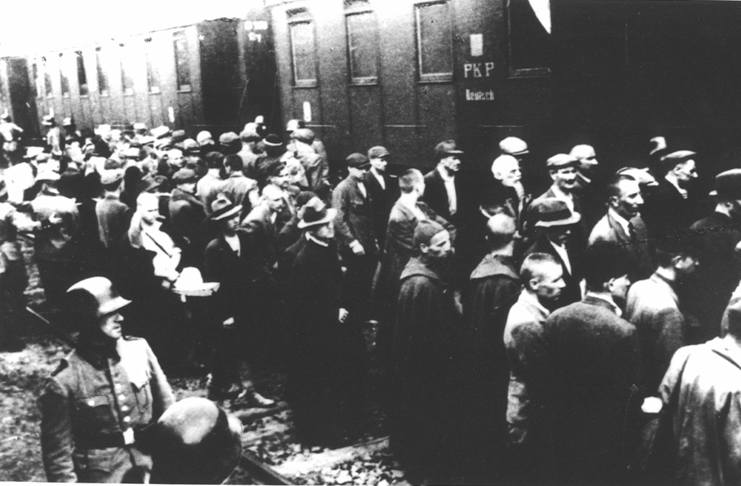An idea of establishing a concentration camp in Auschwitz arose in late 1939 in the Office of the SS and Police headquarters in Wroclaw (der Höhere SS-und Polizeiführer Südost), which was headed by SS Gruppenführer (SS-Group Leader) Erich von dem Bach-Zelewski.
Military barracks were thought to be the best place to set up the camp, as prisoners could be housed in them immediately. The chosen barracks were outside the compact built-up area of Auschwitz, which lay in the Zasole district, in the fork of the Vistula and the Sola rivers. This location would both enable the possible expansion of the camp (if necessary in the future) and ensure the isolation of prisoners, and their whereabouts, from the outside world. A convenient rail link between Auschwitz, Silesia, the General Government, Czechoslovakia and Austria was another advantage. This would ensure the swift transport of the prisoners without any significant logistical problems. In addition, the railway line did not need any reconstruction, which reduced the cost of setting up the camp.
Following an audit, SS Oberführer (SS-Senior Leader) Glücks confirmed the barracks in the Zasole district as the location of the camp, on the condition some sanitary facilities were replenished and some changes were made to its construction. Having fulfilled these conditions and settled negotiations with the Wehrmacht (the area was formally held by the army) a quarantine camp (das Quarantänelager) was intended to operate there immediately.
Finally, on 8th April 1940, Air Force General Halm agreed to lease the Auschwitz barracks to the SS and to conclude an agreement on their transfer to SS jurisdiction.
As the result of a second inspection of Auschwitz on 18th April 1940, headed by SS SS Hauptsturmführer (Chief Assault Leader) Rudolf Höss, on 27th April Himmler gave the order to establish the concentration camp in the former artillery barracks.) Höss, formerly Schutzhaftlagerführer (Protective Custody Camp Leader) in KL Sachsenhausen, was nominated as the first commander of the camp.
According to a Reichsführer SS order, the existing complex of buildings would be transformed into the camp as soon as possible. The camp was mainly constructed by prisoners brought from KL Dachau as so-called ‘external commandos’ (Aussenkommando), as well as Jews and civilian workers. They did the initial work, such as building a fence around the camp, and also renovation and construction work. Gradually the so-called ‘zone of interests’ (Interessengebiet) expanded. People living in this area were sent to work in Germany or were displaced. Most houses and outbuildings were demolished within the zone. The aim of the establishment of the Interessengebiet was to prevent prisoners from both establishing contact with the Polish civilians and from escaping.
The first prisoners in KL Auschwitz were German criminals brought from KL Sachsenhausen by Rapportführer (Report Leader) Gerhard Palitzsch. They were given numbers, from 1 to 30, and were designated ‘prisoner functionaries’ whose role would be to supervise the rest of the prisoners.
On 14th June 1940, the day recognized as the date of the establishment of the camp, the first transport of 728 prisoners arrived in KL Auschwitz from the prison in Tarnów. The prisoners received prison numbers from 31 to 758. These were mainly young people, so-called ‘Sikorski tourists’, who had been detained while trying to cross the Polish-Slovakian border. This group of ‘tourists’ had been attempting to travel via Hungary or Romania to the Polish Army, which had been reconstituted in France. Those captured by the Border Protection (Grenzschutz) became first prisoners of one of the biggest German nazi death conglomerate. As the area of the camp had not been sufficiently prepared, the group was placed in the former buildings of the tobacco monopoly company. Their time there was intended to be a so-called quarantine period for the newly settled.
On 8th June 2006 The Polish Parliament passed a resolution in which 14th June was established as the National Day of Remembrance for Victims of the Nazi Concentration Camps. The Parliament undertook the citizens' initiative forced for many years by the Christian Association of Auschwitz Families (Chrześcijańskie Stowarzyszenie Rodzin Oświęcimskich). The association is also the main organizer of events commemorating the first transport to Auschwitz. Every 14th of June, at the ‘Wall of Death’ in the courtyard between blocks 11 and 10 in KL Auschwitz, people lay flowers and former prisoners leave their messages to young people.
The establishment of the National Day of Remembrance for Victims of the Nazi Concentration Camps is also an attempt to break the stereotype of ‘the Polish camps of death’, as it also shows the multitude of nationalities that experienced the Nazi concentration camps.
Daria Czarnecka
This article was prepared in cooperation with Historykon.pl.
